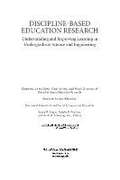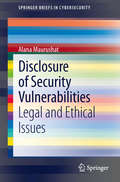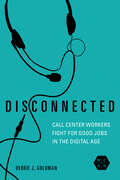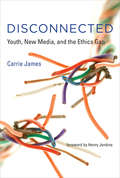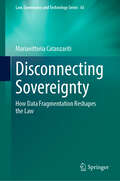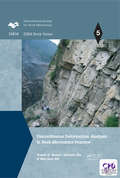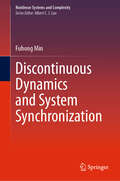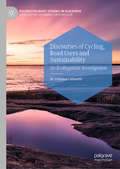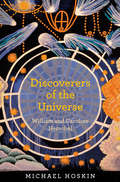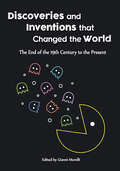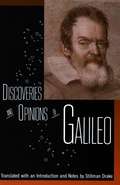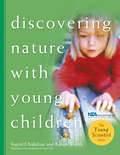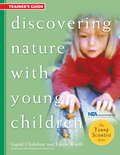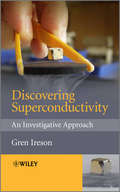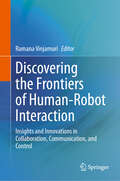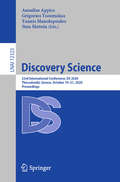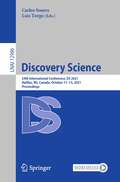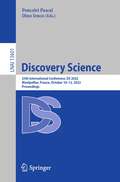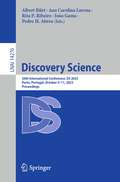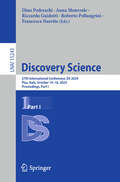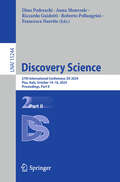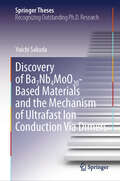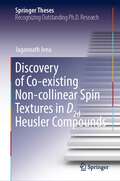- Table View
- List View
Discipline-Based Education Research
by Susan R. SingerThe National Science Foundation funded a synthesis study on the status, contributions, and future direction of discipline-based education research (DBER) in physics, biological sciences, geosciences, and chemistry. DBER combines knowledge of teaching and learning with deep knowledge of discipline-specific science content. It describes the discipline-specific difficulties learners face and the specialized intellectual and instructional resources that can facilitate student understanding. Discipline-Based Education Research is based on a 30-month study built on two workshops held in 2008 to explore evidence on promising practices in undergraduate science, technology, engineering, and mathematics (STEM) education. This book asks questions that are essential to advancing DBER and broadening its impact on undergraduate science teaching and learning. The book provides empirical research on undergraduate teaching and learning in the sciences, explores the extent to which this research currently influences undergraduate instruction, and identifies the intellectual and material resources required to further develop DBER. Discipline-Based Education Research provides guidance for future DBER research. In addition, the findings and recommendations of this report may invite, if not assist, post-secondary institutions to increase interest and research activity in DBER and improve its quality and usefulness across all natural science disciples, as well as guide instruction and assessment across natural science courses to improve student learning. The book brings greater focus to issues of student attrition in the natural sciences that are related to the quality of instruction. Discipline-Based Education Research will be of interest to educators, policy makers, researchers, scholars, decision makers in universities, government agencies, curriculum developers, research sponsors, and education advocacy groups.
Disclosure of Security Vulnerabilities
by Alana MaurushatMuch debate has been given as to whether computer security is improved through the full disclosure of security vulnerabilities versus keeping the problems private and unspoken. Although there is still tension between those who feel strongly about the subject, a middle ground of responsible disclosure seems to have emerged. Unfortunately, just as we've moved into an era with more responsible disclosure, it would seem that a market has emerged for security vulnerabilities and zero day exploits. Disclosure of Security Vulnerabilities: Legal and Ethical Issues considers both the ethical and legal issues involved with the disclosure of vulnerabilities and explores the ways in which law might respond to these challenges.
Disconnected: Call Center Workers Fight for Good Jobs in the Digital Age (Working Class in American History)
by Debbie J. GoldmanCall center employees once blended skill and emotional intelligence to solve customer problems while the workplace itself encouraged camaraderie and job satisfaction. Ten years after telecom industry deregulation, management had isolated the largely female workforce in cubicles, imposed quotas to sell products, and installed surveillance systems that tracked every call and keystroke. Debbie J. Goldman explores how call center employees and their union fought for good, humane jobs in the face of degraded working conditions and lowered wages. As the workforce coalesced to resist the changes, it demanded the Communications Workers of America (CWA) fight for safe and secure good-paying jobs. But trends in technology, capitalism, and corporate governance--combined with the decline of unions--narrowed the negotiating options for workers. Goldman describes how the actions of workers, management, and policymakers shaped the social impact of the new digital technologies and gave new form to the telecommunications industry in a time of momentous change. Perceptive and nuanced, Disconnected tells an overlooked story of service workers in a time of change.
Disconnected: Youth, New Media, and the Ethics Gap (The John D. and Catherine T. MacArthur Foundation Series on Digital Media and Learning)
by Carrie JamesHow young people think about the moral and ethical dilemmas they encounter when they share and use online content and participate in online communities.Fresh from a party, a teen posts a photo on Facebook of a friend drinking a beer. A college student repurposes an article from Wikipedia for a paper. A group of players in a multiplayer online game routinely cheat new players by selling them worthless virtual accessories for high prices. In Disconnected, Carrie James examines how young people and the adults in their lives think about these sorts of online dilemmas, describing ethical blind spots and disconnects. Drawing on extensive interviews with young people between the ages of 10 and 25, James describes the nature of their thinking about privacy, property, and participation online. She identifies three ways that young people approach online activities. A teen might practice self-focused thinking, concerned mostly about consequences for herself; moral thinking, concerned about the consequences for people he knows; or ethical thinking, concerned about unknown individuals and larger communities. James finds, among other things, that youth are often blind to moral or ethical concerns about privacy; that attitudes toward property range from “what's theirs is theirs” to “free for all”; that hostile speech can be met with a belief that online content is “just a joke”; and that adults who are consulted about such dilemmas often emphasize personal safety issues over online ethics and citizenship. Considering ways to address the digital ethics gap, James offers a vision of conscientious connectivity, which involves ethical thinking skills but, perhaps more important, is marked by sensitivity to the dilemmas posed by online life, a motivation to wrestle with them, and a sense of moral agency that supports socially positive online actions.
Disconnecting Sovereignty: How Data Fragmentation Reshapes the Law (Law, Governance and Technology Series #65)
by Mariavittoria CatanzaritiThis book explores the dynamic legal semantics of territory as applied to data. It offers a theoretical assessment of the legal challenges that data flows pose for the principle of territoriality and for state sovereignty more generally. The concept of sovereignty has traditionally developed in close connection with the exercise of powers over a territory, and ideas of jurisdiction have always been based on the principle of territoriality. Digitalization questions however the very idea of physical frontiers. Interconnected networks make data in effect borderless. Data can in fact be created, stored, processed, and accessed anytime and from anywhere. The idea of the book is upbeat: the law can keep pace with the ability of data to fragment reality. The condition for this is that sovereignty disconnects from territory. Disconnection is not getting rid of the territory once and for all, it only means that for data alternatives to the territorial connection exist. The analysis focuses on data from a holistic perspective (personal and nonpersonal) with the aim of investigating divergent and convergent solutions provided by different branches of the law (data protection, IP law, international law, and fundamental rights protection). It assesses in particular, the relationships between digitalization and the principle of territoriality, focusing on the specific legal aspects: the connections between law and territory; the impact of digitalization on state sovereignty; the use of extraterritoriality to circumvent territorial limitations on data flows; the rise of digital jurisdiction and its challenges; the interplay between digital jurisdiction and state sovereignty, and the alternative technological and legal solutions to data localization.
Discontinuities and Defects Training Workbook
by Staff of Hobart Institute of Welding TechnologyDiscontinuities and Defects Training Workbook
Discontinuous Deformation Analysis in Rock Mechanics Practice (ISRM Book Series)
by Yossef H. Hatzor Guowei Ma Gen-hua ShiThe numerical, discrete element, Discontinuous Deformation Analysis (DDA) method was developed by Dr. Gen-hua Shi while he was working at the University of California, Berkeley, under the supervision of Prof. Richard E. Goodman in the late 1980s. Two-dimensional DDA was published in 1993 and three-dimensional DDA in 2001. Since its publication DDA has been verified, validated and applied in numerous studies worldwide and is now considered a powerful and robust method to address both static and dynamic engineering problems in discontinuous rock masses.In this book Yossef H. Hatzor and Guowei Ma, co-chairs of the International Society for Rock Mechanics (ISRM) Commission on DDA, join Dr. Shi in authoring a monograph that presents the state of the art in DDA research. A comprehensive discussion of DDA development since its publication is provided in Chapter 1, followed by concise reviews of 2D and 3D DDA in chapters 2 and 3. Procedures to select geological and numerical input parameters for DDA are discussed in Chapter 4, and DDA validation and verification is presented in Chapter 5. Applications of DDA in underground and rock slope engineering projects are discussed in chapters 6 and 7. In Chapter 8 the novel contact theory recently developed by Dr. Shi is published in its complete form, for the first time. This book is published within the framework of the ISRM Book Series and is the contribution of the ISRM DDA Commission to the international rock mechanics community.
Discontinuous Dynamics and System Synchronization (Nonlinear Systems and Complexity #39)
by Fuhong MinThis book provides a systematic introduction to the dynamical behaviors of discontinuous dynamical systems and system synchronization. The first part of the book presents the theory of flow switching in discontinuous dynamical systems as well as the switching dynamics in such discontinuous systems. The second part presents a theory for interaction discontinuities between distinct dynamical systems, from which partial and complete chaotic synchronizations in such systems are studied analytically and experimentally.
Discourses of Cycling, Road Users and Sustainability: An Ecolinguistic Investigation (Postdisciplinary Studies in Discourse)
by M. Cristina CaimottoThis book employs a Critical Discourse Studies (CDS) framework to examine cycling mobility, marking a new turn in ecolinguistic discourse analysis. The author focuses specifically on environment-related arguments concerning the promotion of higher levels of cycling, mainly as a means of transport, and investigates the “US vs. “THEM” narratives present in many discourses about road users. Analysing newspaper articles, institutional documents and spoken interviews, the author searches for a positive new discourse that would inspire and encourage cycling as a habitual means of transport, rather than simply exposing ecologically destructive discourse. The book will be of interest to discourse and ecolingusitics scholars, as well as contributing to the lively debate about how to increase cycling in fields such as sustainability, sociology, transport planning and management.
Discoverers of the Universe: William and Caroline Herschel
by Michael HoskinDiscoverers of the Universe tells the gripping story of William Herschel, the brilliant, fiercely ambitious, emotionally complex musician and composer who became court astronomer to Britain's King George III, and of William's sister, Caroline, who assisted him in his observations of the night sky and became an accomplished astronomer in her own right. Together, they transformed our view of the universe from the unchanging, mechanical creation of Newton's clockmaker god to the ever-evolving, incredibly dynamic cosmos that it truly is. William was in his forties when his amateur observations using a homemade telescope led to his discovery of Uranus, and an invitation to King George's court. He coined the term "asteroid," discovered infrared radiation, was the first to realize that our solar system is moving through space, discovered 2,500 nebulae that form the basis of the catalog astronomers use today, and was unrivalled as a telescope builder. Caroline shared William's passion for astronomy, recording his observations during night watches and organizing his papers for publication. She was the first salaried woman astronomer in history, a pioneer who herself discovered nine comets and became a role model for women in the sciences. Written by the world's premier expert on the Herschels, Discoverers of the Universe traces William and Caroline's many extraordinary contributions to astronomy, shedding new light on their productive but complicated relationship, and setting their scientific achievements in the context of their personal struggles, larger-than-life ambitions, bitter disappointments, and astonishing triumphs.
Discoverers of the Universe: William and Caroline Herschel
by Michael HoskinDiscoverers of the Universe tells the gripping story of William Herschel, the brilliant, fiercely ambitious, emotionally complex musician and composer who became court astronomer to Britain's King George III, and of William's sister, Caroline, who assisted him in his observations of the night sky and became an accomplished astronomer in her own right. Together, they transformed our view of the universe from the unchanging, mechanical creation of Newton's clockmaker god to the ever-evolving, incredibly dynamic cosmos that it truly is. William was in his forties when his amateur observations using a homemade telescope led to his discovery of Uranus, and an invitation to King George's court. He coined the term "asteroid," discovered infrared radiation, was the first to realize that our solar system is moving through space, discovered 2,500 nebulae that form the basis of the catalog astronomers use today, and was unrivalled as a telescope builder. Caroline shared William's passion for astronomy, recording his observations during night watches and organizing his papers for publication. She was the first salaried woman astronomer in history, a pioneer who herself discovered nine comets and became a role model for women in the sciences. Written by the world's premier expert on the Herschels, Discoverers of the Universe traces William and Caroline's many extraordinary contributions to astronomy, shedding new light on their productive but complicated relationship, and setting their scientific achievements in the context of their personal struggles, larger-than-life ambitions, bitter disappointments, and astonishing triumphs.
Discoveries and Inventions that Changed the World: The End of the 19th Century to the Present
by Gianni MorelliSome of the Greatest Inventions of All TimeLearn about some of the greatest inventions of all time and how they changed our world forever in this fascinating book of inventions and daring discoveries.World changing history. Who created plastic? How was the zipper invented? Who created the aspirin that takes away our headaches? All of these questions (and more) are answered by author Gianni Morelli who expertly delves into the fascinating facts behind some of the most important historical inventions since the end of the 19th century.Historical inventions and life-changing discoveries. From ground-breaking technology to life-changing advances in medicine, travel through time in this impressive book of discoveries and inventions. You’ll look at our world in a completely different light after learning how we got to where we are today.Inside, you’ll find:A way to connect our present to our past, giving hope for the possibilities of tomorrowMeaningful knowledge of world changing historyA deeper understanding of the world around usIf you liked books such as Power and Progress, Invention and Innovation, or ColdFusion Presents: New Thinking, you’ll love Discoveries and Inventions that Changed the World.
Discoveries and Opinions of Galileo
by Galileo GalileiDirecting his polemics against the pedantry of his time, Galileo, as his own popularizer, addressed his writings to contemporary laymen. His support of Copernican cosmology, against the Church's strong opposition, his development of a telescope, and his unorthodox opinions as a philosopher of science were the central concerns of his career and the subjects of four of his most important writings. Drake's introductory essay place them in their biographical and historical context. Translation and notes by Stillman Drake
Discovering Nature with Young Children
by Karen Worth Ingrid ChalufourField-tested across the country, this comprehensive curriculum expands and extends the role science has traditionally played in the early childhood classroom. The first in a new series, Discovering Nature with Young Children explores the wide-ranging elements that make up the natural world around us. The curriculum replaces simple fact-feeding practices with the development of long-term scientific reasoning, including literacy skills and numeracy skills, such as hypothesis, inference, prediction, and estimation.
Discovering Nature with Young Children: Trainer's
by Karen Worth Ingrid ChalufourField-tested across the country, this comprehensive curriculum expands and extends the role science has traditionally played in the early childhood classroom. The first in a new series, Discovering Nature with Young Children explores the wide-ranging elements that make up the natural world around us. The curriculum replaces simple fact-feeding practices with the development of long-term scientific reasoning, including literacy skills and numeracy skills, such as hypothesis, inference, prediction, and estimation. A companion to the curriculum, this trainer's guide serves as an indispensable handbook for trainers and administrators interested in introducing staff to the curriculum--from planning to implementation. Special sections outline the curriculum and introduce scientific reasoning to adults, and eight workshops detail the complete curriculum for staff members. The guide also includes strategies for supporting teachers over time through mentoring and guided discussions.
Discovering Superconductivity
by Gren IresonSuperconductivity is a quantum phenomenon that manifests itself in materials showing zero electrical resistance below a characteristic temperature resulting in the potential for an electric current to run continually through such a material without the need for a power source. Such materials are used extensively in medical and power applications, e.g. MRI and NMR machines. Discovering Superconductivity uses a series of practical and investigative activities, which can be used as tutor demonstrations or as student lab exercises. This highly illustrated text features the following sections: Introduction - including a brief history of superconductivitySuperconductivity - an explanation of the phenomenon and its effectsSuperconducting materials - including High & Low temperature superconductorsApplications - how superconductivity is used in medical imaging, at CERN and in the Maglev trainsThis text will serve as an excellent introduction for students, with or without a physics background, to superconductivity. With a strong practical, experimental emphasis, it provides readers with an overview of the topic preparing them for more advanced texts used in advanced undergraduate and post-graduate courses. PowerPoint files of the figures presented within this text are available at: http://booksupport.wiley.comA word from the author: "The intention of this text is to introduce the reader to the study of superconductivity via a minds-on approach......... The minds-on approach takes this a stage further by requiring the learner to engage with the process to a greater extent."
Discovering the Frontiers of Human-Robot Interaction: Insights and Innovations in Collaboration, Communication, and Control
by Ramana VinjamuriThe field of Human-Robot Interaction (HRI) is rapidly evolving, blurring the lines between human and machine capabilities. Recent advances in computer science, computer vision, artificial intelligence, robotics, brain-computer interfaces, neural engineering, and cognitive science have profoundly transformed HRI. As we stand on the threshold of a new era characterized by increasingly sophisticated human-machine interactions, it becomes imperative to explore the emerging frontiers of this dynamic field. Robots are now entering homes, workplaces, and even battlefields, necessitating a deeper understanding of effective, safe, and ethical human-robot interaction. This book delves into cutting-edge research shaping the future of HRI, representing a collective effort to navigate uncharted territories. Through diverse chapters authored by leading experts, it offers a comprehensive exploration of the latest developments, challenges, and opportunities in HRI. By examining technical, engineering, and methodological challenges, this volume brings together perspectives from researchers, engineers, and designers to provide a comprehensive view of this dynamic field. Aiming to showcase groundbreaking research and spark interdisciplinary dialogue and collaboration, this book is a valuable resource for researchers, engineers, students, and anyone interested in the future of human-robot collaboration. Whether you are a seasoned roboticist, a curious student, or simply interested in future technology, this book offers insights and knowledge to navigate the complex world of human-robot interaction. Join us on this journey of discovery as we navigate the emerging frontiers of human-robot interaction together.
Discovery Science: 23rd International Conference, DS 2020, Thessaloniki, Greece, October 19–21, 2020, Proceedings (Lecture Notes in Computer Science #12323)
by Yannis Manolopoulos Annalisa Appice Stan Matwin Grigorios TsoumakasThis book constitutes the proceedings of the 23rd International Conference on Discovery Science, DS 2020, which took place during October 19-21, 2020. The conference was planned to take place in Thessaloniki, Greece, but had to change to an online format due to the COVID-19 pandemic. The 26 full and 19 short papers presented in this volume were carefully reviewed and selected from 76 submissions. The contributions were organized in topical sections named: classification; clustering; data and knowledge representation; data streams; distributed processing; ensembles; explainable and interpretable machine learning; graph and network mining; multi-target models; neural networks and deep learning; and spatial, temporal and spatiotemporal data.
Discovery Science: 24th International Conference, DS 2021, Halifax, NS, Canada, October 11–13, 2021, Proceedings (Lecture Notes in Computer Science #12986)
by Carlos Soares Luis TorgoThis book constitutes the proceedings of the 24th International Conference on Discovery Science, DS 2021, which took place virtually during October 11-13, 2021.The 36 papers presented in this volume were carefully reviewed and selected from 76 submissions. The contributions were organized in topical sections named: applications; classification; data streams; graph and network mining; machine learning for COVID-19; neural networks and deep learning; preferences and recommender systems; representation learning and feature selection; responsible artificial intelligence; and spatial, temporal and spatiotemporal data.
Discovery Science: 25th International Conference, DS 2022, Montpellier, France, October 10–12, 2022, Proceedings (Lecture Notes in Computer Science #13601)
by Poncelet Pascal Dino IencoThis book constitutes the proceedings of the 25th International Conference on Discovery Science, DS 2022, which took place virtually during October 10-12, 2022. The 27 full papers and 12 short papers presented in this volume were carefully reviewed and selected from 59 submissions.
Discovery Science: 26th International Conference, DS 2023, Porto, Portugal, October 9–11, 2023, Proceedings (Lecture Notes in Computer Science #14276)
by João Gama Albert Bifet Rita P. Ribeiro Ana Carolina Lorena Pedro H. AbreuThis book constitutes the proceedings of the 26th International Conference on Discovery Science, DS 2023, which took place in Porto, Portugal, in October 2023. The 37 full papers and 10 short papers presented in this volume were carefully reviewed and selected from 133 submissions. They were organized in topical sections as follows: Machine learning methods and applications; natural language processing and social media analysis; interpretability and explainability in AI; data analysis and optimization; fairness, privacy and security in AI; control and spatio-temporal modeling; graph theory and network analysis; time series and forecasting; healthcare and biological data analysis; anomaly, outlier and novelty detection.
Discovery Science: 27th International Conference, DS 2024, Pisa, Italy, October 14–16, 2024, Proceedings, Part I (Lecture Notes in Computer Science #15243)
by Dino Pedreschi Riccardo Guidotti Anna Monreale Roberto Pellungrini Francesca NarettoThe two-volume set LNAI 15243 + 15244 constitutes the proceedings of the 27th International Conference on Discovery Science, DS 2024, which took place in Pisa, Italy, during October 14-16, 2024. The 53 full papers presented in the proceedings were carefully reviewed and selected from 121 submissions. They were organized in topical sections as follows: Part I: LLM, Text Analytics, and Ethical Aspects of AI; Natural Language Processing, Sequential Data and Science Discovery; Data-Driven Science Discovery Methodologies; Graph Neural Network, Graph Theory, Unsupervised Learning and Regression; Part II: Tree-Based Models and Causal Discovery; Security and Anomaly Detection; Computer Vision and Explainable AI; Classification Models; SoBigData++: City for Citizens and Explainable AI; SoBigData++: Societal Debates and Misinformation Analysis.
Discovery Science: 27th International Conference, DS 2024, Pisa, Italy, October 14–16, 2024, Proceedings, Part II (Lecture Notes in Computer Science #15244)
by Dino Pedreschi Riccardo Guidotti Anna Monreale Roberto Pellungrini Francesca NarettoThe two-volume set LNAI 15243 + 15244 constitutes the proceedings of the 27th International Conference on Discovery Science, DS 2024, which took place in Pisa, Italy, during October 14-16, 2024. The 53 full papers presented in the proceedings were carefully reviewed and selected from 121 submissions. They were organized in topical sections as follows: Part I: LLM, Text Analytics, and Ethical Aspects of AI; Natural Language Processing, Sequential Data and Science Discovery; Data-Driven Science Discovery Methodologies; Graph Neural Network, Graph Theory, Unsupervised Learning and Regression; Part II: Tree-Based Models and Causal Discovery; Security and Anomaly Detection; Computer Vision and Explainable AI; Classification Models; SoBigData++: City for Citizens and Explainable AI; SoBigData++: Societal Debates and Misinformation Analysis.
Discovery of Ba7Nb4MoO20-Based Materials and the Mechanism of Ultrafast Ion Conduction Via Dimers (Springer Theses)
by Yuichi SakudaThis book provides detailed descriptions of strategies for improving ion conductivity and the factors that result in high ion conductivity. In this book, discovery of novel materials that exhibit higher ion conductivity than practical materials is introduced to clarify the migration mechanism of oxide ions and protons. The book shows that the bulk conductivity of hexagonal perovskite-related oxide Ba7Nb3.8Mo1.2O20.1 in dry air is 1.1 mS/cm at 306 °C, which is 175 times higher than that of practical materials (ZrO2)0.92(Y2O3)0.08 (8YSZ). Also, as a new approach to the subject, by ab initio molecular dynamics (AIMD) simulations and neutron-diffraction experiments, the mechanism is shown that the oxide ions migrate by the breaking and reforming of M2O9 (M = Nb, Mo) dimers, MO5 monomers and MO4 tetrahedra. The oxide-ion migration is reminiscent of a concerted push-pull interstitialcy ‘bucket-relay’-type motions. Readers can understand the oxide-ion and proton migration mechanism in terms of crystal structure. Recently, materials that exhibit high ionic conductivity have been discovered one after another.
Discovery of Co-existing Non-collinear Spin Textures in D2d Heusler Compounds (Springer Theses)
by Jagannath JenaNon-collinear spin textures have attracted significant attention due to their topological nature, emergent electromagnetic properties, and potential spintronic and magnonic device applications. This book explores the physical properties of distinct spin textures in D2d compounds. The main goals of the work are (a) discovering new spin textures in D2d Heusler compounds and studying their detailed properties to enrich the field of non-collinear magnetism (b) optimizing the nano-track geometry and generating isolated and single chains of nano-objects that will establish new hallmarks for technological applications (c) studying the stability of spin textures with magnetic fields and temperatures and finding a way to observe the striking behavior of spin textures near the specimen edges. The first few chapters provide a brief overview of spin textures such as Bloch and Néel skyrmions. In the experimental methods section, the author shows how to identify the single-crystalline grains of a polycrystalline sample, how to make single-crystalline thin specimens and nano-tracks, and then provides explicit descriptions of different imaging techniques performed on a transmission electron microscope. This part will be valuable for beginners wishing to conduct research in experimental nano-magnetism and transmission electron microscope imaging. The core results of the book are presented in four chapters, describing the discovery of several new and unanticipated spin textures, namely square-shaped antiskyrmions, elliptical Bloch skyrmions, fractional antiskyrmions, fractional Bloch skyrmions and elongated (anti)skyrmions in a single D2d Heusler compound. It is shown that these textures can be understood by a combination of dipole-dipole interactions and a chiral vector exchange that makes it possible to stabilize various spin textures even in the same compound. The D2d compounds are the first non-centrosymmetric systems shown to host several co-existing non-collinear spin textures.
